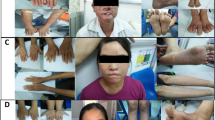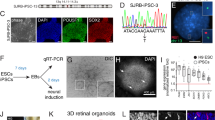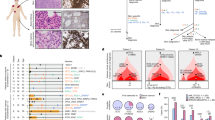Abstract
RETINOBLASTOMA is a rare malignant eye tumour which appears spontaneously or occurs in genetically predisposed persons1–3. The latter group is composed of patients who inherit the tumour with a dominant mode of transmission (80–90% penetrance) (referred to as the familial type) or those who bear a deletion in the long arm of chromosome 13 (13q-) (referred to as the D-deletion type). When this deletion is present, it is observed in many somatic cells and is often associated with structural defects such as microcephaly, micropthalmia and several skeletal and genitourinary abnormalities3,4. Survivors of the genetic forms of retinoblastoma have an increased risk for the development of cancers at other sites, while patients who survive the sporadic type do not2–6. A single genetic locus is unlikely to predispose many somatic cells to tumour formation unless a fundamental molecular defect—for example, related to DNA repair—is present. To investigate this hypothesis, we have examined the in vitro X-ray sensitivity of skin fibroblast strains derived from three retinoblastoma patients—a pair of twins with the familial type accompanied by no gross chromosome abnormalities, and a patient with the D-deletion type. We also used two normal fibroblast strains and a strain from a patient with ataxia telangiectasia. We found that the strain derived from the D-deletion retinoblastoma patient was significantly more radiosensitive than the two normal strains, but not as sensitive as that from the ataxia patient.
This is a preview of subscription content, access via your institution
Access options
Subscribe to this journal
Receive 51 print issues and online access
$199.00 per year
only $3.90 per issue
Buy this article
- Purchase on Springer Link
- Instant access to full article PDF
Prices may be subject to local taxes which are calculated during checkout
Similar content being viewed by others
References
Knudson, A. G. Proc. natn. Acad. Sci. U.S.A. 68, 820–823 (1971).
Lancet ii, 1016–1017 (1971).
Knudson, A. G., Meadows, A. T., Nichols, W. W. & Hill, R. New Engl. J. Med. 295, 1120–1123 (1976).
Francke, U. Cytogenet. Cell Genet. 16, 131–134 (1976).
Strong, L. C. & Knudson, A. G. Lancet ii, 1086 (1973).
Jensen, R. D. & Miller, R. W. New Engl. J. Med. 285, 307–311 (1971).
Taylor, A. M. R. et al. Nature 258, 427–429 (1975).
Paterson, M. C., Smith, B. P., Lohman, P. H. M., Anderson, A. K. & Fishman, L. Nature 260, 444–447 (1976).
Weichselbaum, R., Epstein, J. & Little, J. B. Radiology 121, 479–482 (1976).
Cleaver, J. Nature 218, 652–656 (1968).
Author information
Authors and Affiliations
Rights and permissions
About this article
Cite this article
WEICHSELBAUM, R., NOVE, J. & LITTLE, J. Skin fibroblasts from a D-deletion type retinoblastoma patient are abnormally X-ray sensitive. Nature 266, 726–727 (1977). https://doi.org/10.1038/266726a0
Received:
Accepted:
Issue Date:
DOI: https://doi.org/10.1038/266726a0
This article is cited by
-
Cell-culture studies on neurofibromatosis (von Recklinghausen's disease)
Archives of Dermatological Research (1985)
-
Genetic recombination of Herpes simplex virus, the role of the host cell and UV-irradiation of the virus
Molecular and General Genetics MGG (1980)
-
Repair deficient human disorders and cancer
Nature (1978)
Comments
By submitting a comment you agree to abide by our Terms and Community Guidelines. If you find something abusive or that does not comply with our terms or guidelines please flag it as inappropriate.



